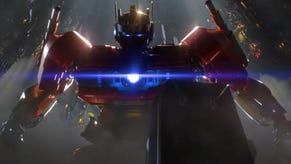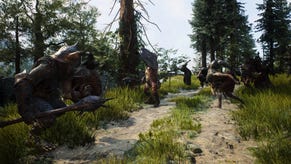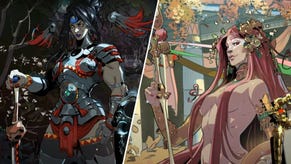Only human: Tomb Raider charts the rise of an icon
Stace Harman gets reacquainted with Lara Croft and finds that he misses her super-hero powers of old not one bit.
Of all of the Tomb Raider games, it’s the conclusion of Tomb Raider II that I best remember. It’s stuck with me for 15 years because at the end of the 1997 sequel, Core Design, then custodians of the franchise, broke the fourth wall by having Lara, who looked about to de-robe to step into the shower, turn to the camera armed with a shotgun to demand of me: “Don’t you think you’ve seen enough?” The shot she fired reverberated in sound and resonance around my teenage mind as the screen faded to black.
It was Core Design giving a knowing nod to Lara’s sex-symbol status, but it was also an attempt to position Lara as a character who was outside of my control. It told me that when the camera stopped rolling and the controller was put away, Lara continued to exist and that despite my own feelings toward her – be they protective, possessive, perverted or all three – she was, at her core, a loner who didn’t need me or a companion of any sorts (the notable exception being her butler, who could be locked in the walk-in freezer for countless moments of teenage hilarity).
The opening stages of Crystal Dynamics’ series reboot take the image of Lara I’ve held in my head for 16 years, pull it apart and scatter it to the four winds of a remote, untamed island in the Pacific Ocean. Lara’s iconic aesthetics are gone: the twin pistols with their infinite ammo, the shorts, the cocksure smile that once tugged at the corner of her mouth, but more affecting is the absence of Lara’s agility, sure footedness and physical and mental preparedness for any situation.
Where once there was a there was a pithy remark there’s now ragged breathing, where previously there was an acrobatic tumble there’s now unsure scampering and the near-perfect swan dive has been replaced by a heavy, crunchy landing with hands outstretched for balance. In many ways, Lara is less than her former self, but in others she’s much more.
Where once there was a pithy remark there’s now ragged breathing, where previously there was an acrobatic tumble there’s now unsure scampering and the near-perfect swan dive has been replaced by a heavy, crunchy landing with hands outstretched for balance.
“Lara knows that she might be the reason that they’re on this island and she feels remorseful and responsible for that,” explains global brand director, Karl Stewart.
“She feels that she has to save the people that she put in danger, and that’s where she draws her motivation from; we want the player to feel at the beginning that it’s all about her: she gets her bow, she kills to eat, she’s attacked by wolves, and so on.
"We’re starting to see her grow as a character to point where after her friend gets kidnapped she’s resolute and we reach a point where she starts to uncover things on the island that begin to turn her into the person that she needs to be: that strong, determined action-adventure hero.”
These milestones are reached relatively early in the game, but while it’s clear that Lara doesn’t remain entirely vulnerable for long, it’s enough to shake me out of the old way of thinking and encourage me to examine the new, modern approach to Tomb Raider; an approach that brings with it many modern game play tropes; some of which are more welcome than others.
Growing pains
Lara grows not just in narrative sense, but in her abilities too, as she earns survival experience that become points to be spent on skills focused on ingenuity or combat. So intrinsic is the survival mechanic and subsequent investment in abilities and equipment that it further enforces how outdated the old Tomb Raider model was.
The sprawling island, of which we’re shown just a small part, invites exploration and rewards a more considered pace. It pays to be mindful of the closest camp site as bonfires mark the point where Lara’s abilities can be upgraded, which occasionally calls to mind adventures had with Geralt of Rivia or the silent protagonist of From Software’s seminal Souls series.
Of course, these are light RPG elements at best, but they suit Lara’s tale of progression and mark a new direction for Tomb Raider which does much to distance it from lazy comparisons with Naughty Dog’s Uncharted outings.
Other modernised features are less welcome, though the complaints are as much of standardised video game zeitgeist as they are of Crystal Dynamics’ design choices and, as such, many people will either disregard them or fail to notice anything amiss. Silly things, like once Lara finds her bow – a weapon that’s authentically crude in its construction, consisting of a number thin, flexible tree branches lashed together – she begins to find arrows strewn all over the environment, and not odd arrows protruding from trees and carcasses, but whole gleaming quivers of them propped up against trees and behind walls.
It’s a standard video game solution to an age old problem, but because of the efforts to cast Lara as a survivor against the odds, it jars – a basic, one-step crafting process to make more arrows would have been welcome, as would the necessity to retrieve arrows from fallen foes.
Survival Instinct, Lara’s equivalent of Eagle Vision/Detective Mode/Instinct Mode, is less easy to ignore. It is, ostensibly, an optional mechanic and, again, is a fairly standard solution to a recognised problem: as game worlds become more complex, game designers want to offer players an unobtrusive tool to help them find their way and stave off frustration.
But while Survival Instinct is optional, from a narrative perspective it is inexplicable. Ezio, Batman and Agent 47’s uncanny parallel ability can be explained by technology, gadgets or a sixth sense attributed to artificial creation and honed by years of practice. Moreover, it will take several hours of play to determine whether the option to opt-in rings true or whether the level design and objective markers require its use, however occasional.
Gripes aside – and if these should be the worst things to worry about, then we really have nothing to worry about – Tomb Raider shows a great deal of promise and looks set to offer a more organic, less homogenised experience than that of its predecessors.
So, it seems that from the demise of the old order comes a new origin story and whilst I cannot be sure that I’ll remember its end, I’m excited to start exploring its beginning.











